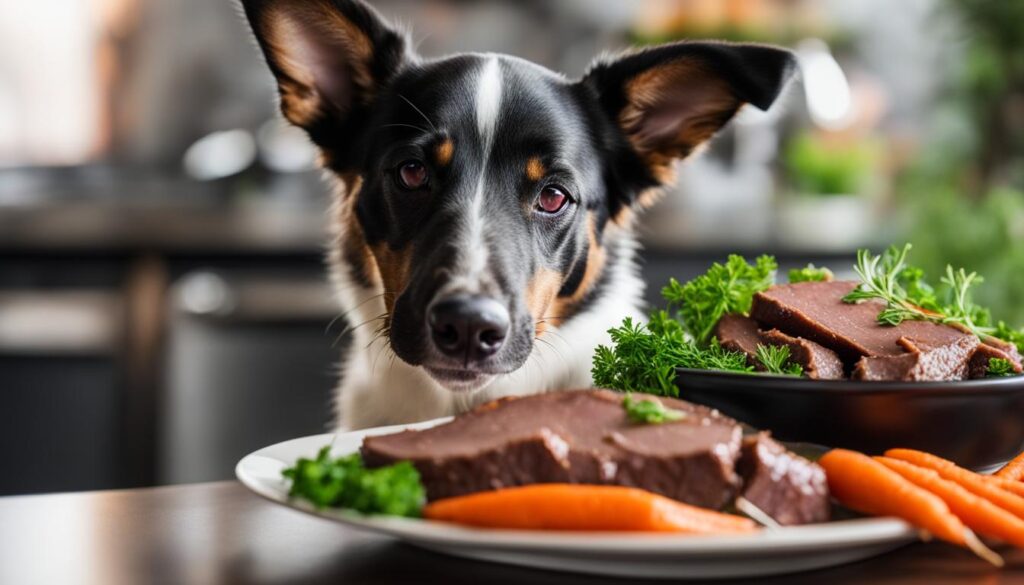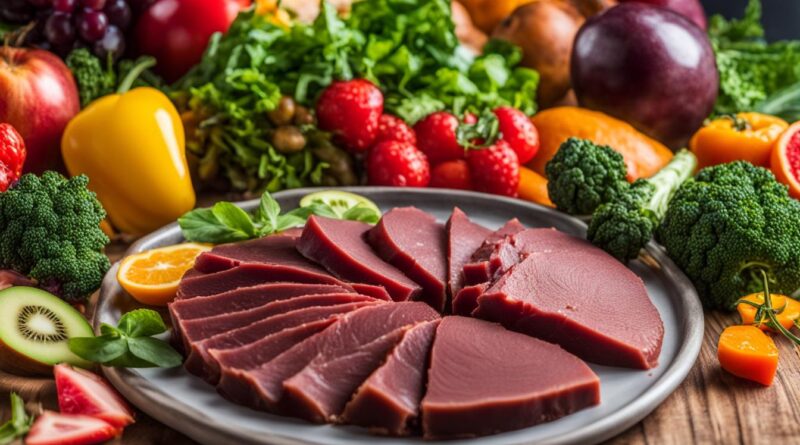Safe Liver Prep for Dogs | Cooking Guide
When it comes to cooking liver for dogs, it’s important to follow safe preparation methods to ensure a nutritious and tasty meal for your furry friend. In this cooking guide, we will provide step-by-step instructions on how to cook liver for dogs, including recommended ingredients and cooking techniques. Whether you’re looking to incorporate liver into your dog’s regular meals or make homemade liver treats, this guide will help you do it safely and effectively.
Why Choose Liver for Dogs? The Nutritional Benefits
Liver is a nutrient powerhouse for dogs, offering a wide range of essential vitamins and minerals. It is particularly rich in vitamin A, B vitamins, iron, and zinc, which are important for supporting your dog’s overall health, immune system, and digestion. Including liver in your dog’s diet can help maintain a healthy skin and coat, promote proper growth and development, and provide important nutrients for their overall well-being.
By understanding the nutritional benefits of liver, you can make informed choices about incorporating it into your dog’s meals.
When it comes to liver nutrition for dogs, incorporating this nutrient-packed organ meat into their diet can have a positive impact on their health. Let’s take a closer look at the key nutritional benefits of liver for dogs:
Vitamin A
Liver is an excellent source of vitamin A, which plays a crucial role in maintaining your dog’s vision, boosting their immune system, and promoting healthy skin and coat. Vitamin A is essential for proper growth and development, making liver an excellent choice for puppies.
B Vitamins
Liver contains a variety of B vitamins, including thiamine, riboflavin, niacin, pantothenic acid, pyridoxine, and cobalamin. These vitamins are important for energy metabolism, supporting the nervous system, and promoting healthy blood cells in dogs.
Iron
Iron is vital for the production of red blood cells, which carry oxygen throughout the body. Liver is rich in iron, making it an excellent option for dogs who may be deficient in this essential mineral.
Zinc
Zinc is crucial for supporting immune function, promoting wound healing, and maintaining healthy skin and coat. Liver is a natural source of zinc, providing dogs with this essential mineral.
By incorporating liver into your dog’s meals, you can ensure they receive these key nutrients that contribute to their overall health and vitality.
Choosing the Right Liver and Ingredients
When preparing liver for dogs, it’s crucial to select high-quality liver from a reputable source. Opt for organic or grass-fed liver as these options guarantee maximum nutritional value while minimizing the risk of harmful additives or chemicals. Choosing the right liver for your furry friend ensures that they receive the best possible meal.
In addition to selecting the right liver, you can enhance the flavor by incorporating dog-friendly seasonings like turmeric or parsley. These natural ingredients not only add taste but also provide additional health benefits for your dog.
By carefully choosing the liver and ingredients you use, you can create a nutritious and delicious meal that your dog will enjoy.
Cooking Methods for Liver
When it comes to cooking liver for dogs, there are a few methods you can use to ensure it’s cooked safely and retains its nutritional value. Two popular cooking methods for liver are boiling and baking.
Boiling
To boil the liver, start by placing it in a pot of water. Make sure the water covers the liver completely. Bring the water to a boil and then reduce the heat to a simmer. Allow the liver to cook in the simmering water for about 15-20 minutes, or until it is fully cooked through.
This cooking method is simple and effective, as boiling helps to remove excess fat from the liver while preserving its nutrients. However, keep in mind that boiling liver can cause a strong odor in your kitchen, so proper ventilation is essential.
Baking
An alternative cooking method for liver is baking. Preheat your oven to 350°F (175°C) and place the liver on a baking sheet lined with parchment paper or aluminum foil. Bake the liver for about 15-20 minutes, or until it is cooked through and no longer pink on the inside.
Baking liver can help retain its moisture and flavor while reducing any strong smells associated with boiling. It also allows you to add seasonings or marinades to enhance the taste, making it a versatile option for cooking liver for your dog.
Remember, regardless of the cooking method you choose, it’s crucial to ensure that the liver is cooked thoroughly to eliminate any raw or undercooked portions. This is especially important to prevent the risk of bacterial contamination that could be harmful to your dog’s health.
“Cooking liver for your dog is a rewarding experience that provides them with essential nutrients.”
Serving Suggestions and Portion Sizes
Once the liver is cooked, there are various ways to serve it to your dog. You can serve it as a standalone treat or mix it with your dog’s regular food to provide a nutrient boost.
Pro Tip: To add variety to your dog’s meals, consider incorporating liver dog food recipes into their diet. These recipes often include other wholesome ingredients that can further enhance the nutritional value and appeal of the meal.
It’s important to consider portion sizes based on your dog’s size and dietary needs. As a general guideline, liver should make up no more than 5% of their total diet. Consult with your veterinarian to determine the appropriate portion size for your dog.
Additionally, liver can be used to make homemade liver dog treats, providing a healthy and tasty option for rewarding them.
Liver Dog Treat Recipe
Here’s a simple recipe for homemade liver dog treats:
| Ingredients | Instructions |
|---|---|
|
|

Benefits of Liver for Dogs
Liver offers a range of benefits for dogs, thanks to its rich nutrient profile. Incorporating liver into your dog’s meals can provide them with important vitamins and minerals that support their overall health and well-being.
1. Immune System Support
Liver is packed with essential nutrients that help strengthen your dog’s immune system. It contains high levels of vitamin A, which plays a key role in maintaining the health of the skin and mucous membranes, helping to keep infections at bay.
2. Digestive Health
The nutritional composition of liver is beneficial for your dog’s digestion. It is rich in B vitamins, including riboflavin and niacin, which aid in the digestion and absorption of nutrients. Additionally, liver contains enzymes that support proper digestion and contribute to a healthy gut.
3. Skin and Coat Health
A healthy liver is essential for maintaining your dog’s skin and coat in optimal condition. Liver is a great source of omega-3 fatty acids, which are known to promote healthy skin and a shiny coat. Furthermore, the vitamin E content found in liver helps protect your dog’s skin cells from damage.
4. Vital Nutrients
Liver is packed with vital nutrients that contribute to your dog’s overall well-being. It is an excellent source of iron, which is essential for the production of red blood cells and oxygen transport throughout the body. Liver also provides important minerals such as zinc, which supports immune function and promotes healthy growth and development.
“Incorporating liver into your dog’s diet can be a beneficial and flavorful way to enhance their nutrition and support their overall health.” – Dr. Sarah Johnson, Veterinarian
By incorporating liver into your dog’s meals, you can ensure they receive the essential nutrients needed to maintain a healthy and balanced diet. Whether you choose to cook liver as a standalone dish or incorporate it into homemade recipes, liver can be a valuable addition to your dog’s nutrition plan.

| Nutrient | Amount per 100g |
|---|---|
| Vitamin A | 56,000 IU |
| Vitamin B12 | 83.1 mcg |
| Iron | 12.3 mg |
| Zinc | 3.9 mg |
Freezing and Storing Cooked Liver
If you have leftover cooked liver, it’s important to store it properly to maintain its freshness and quality. By following some simple steps, you can ensure that your cooked liver stays safe and delicious for your dog. Here are some tips for freezing and storing cooked liver:
Refrigeration
If you plan to use the cooked liver within the next five days, it is best to store it in the refrigerator. Place the cooked liver in an airtight container or wrap it tightly with plastic wrap before refrigerating. This will help prevent any odors from seeping into the liver and keep it fresh for your dog’s next meal.
Freezing
If you have a larger quantity of cooked liver or want to store it for a longer period, freezing is a great option. Freezing allows you to make larger batches of liver dog food recipes or homemade liver dog treats and portion them out as needed. Here’s how to freeze cooked liver:
- Cool the cooked liver completely by allowing it to come to room temperature.
- Once cooled, wrap the cooked liver tightly with freezer-safe packaging, such as freezer bags or aluminum foil. Make sure to remove as much air as possible to prevent freezer burn.
- Label the packaging with the date of freezing to keep track of its freshness.
- Place the wrapped cooked liver in the freezer, ensuring it is stored in a flat position to prevent it from getting crushed or misshapen.
When stored properly, cooked liver can be frozen for up to three months without a significant loss in quality.
Thawing and Serving
When you’re ready to serve the frozen cooked liver to your dog, it’s important to thaw it safely. Here’s how to thaw frozen cooked liver:
- Transfer the frozen liver from the freezer to the refrigerator.
- Allow the liver to thaw slowly in the refrigerator overnight or for a few hours, depending on its size.
- Once thawed, serve the cooked liver to your dog as desired. You can mix it with your dog’s regular food or use it as a standalone treat.
Remember to discard any leftovers that have been sitting at room temperature for more than two hours to ensure your dog’s safety.
Guidelines for Freezing and Storing Cooked Liver
| Storage Method | Duration of Storage |
|---|---|
| Refrigeration | Up to 5 days |
| Freezing | Up to 3 months |
| Thawing | Overnight in the refrigerator |
Conclusion
Cooking liver for dogs provides a wonderful opportunity to create nutritious and flavorful meals that promote their health and well-being. By following safe preparation methods and using high-quality ingredients, you can ensure a delicious and satisfying experience for your furry friend.
Remember to consult with your veterinarian to determine if liver is suitable for your dog’s diet and to receive personalized guidance. They can help you identify the appropriate portion sizes and ensure that your dog receives a well-balanced diet.
With the right knowledge and care, cooking liver for dogs can be a rewarding experience. Whether you’re preparing liver as standalone treats or incorporating it into their regular meals, the nutritional benefits will have a positive impact on their overall health. So go ahead, try out some dog liver recipes and enjoy providing your canine companion with a homemade meal they will absolutely love!
FAQ
How do I choose high-quality liver for my dog?
To ensure the highest nutritional value and minimize the likelihood of harmful additives or chemicals, choose organic or grass-fed liver from a reputable source.
What are some dog-friendly seasonings I can use to enhance the flavor of liver?
Consider using turmeric or parsley as dog-friendly seasonings to enhance the flavor of liver.
What are the recommended cooking methods for liver?
Boiling and baking are two popular options for cooking liver for dogs. Boil the liver in water for about 15-20 minutes or bake it in the oven until done.
How should I serve the cooked liver to my dog?
You can serve the cooked liver as a standalone treat or mix it with your dog’s regular food to provide a nutrient boost. Consult with your veterinarian to determine the appropriate portion size for your dog.
How much liver should I include in my dog’s diet?
Liver should make up no more than 5% of your dog’s total diet. Consult with your veterinarian to determine the appropriate portion size for your dog.
What are the benefits of including liver in my dog’s diet?
Liver supports overall health, including the immune system, digestion, and skin and coat health. It provides important vitamins and minerals that contribute to your dog’s well-being.
How should I store leftover cooked liver?
Leftover cooked liver can be stored in the refrigerator for up to five days in an airtight container. You can also freeze cooked liver for longer storage. Thaw frozen liver in the refrigerator before serving to your dog.
Is it safe to cook liver for dogs?
Yes, it is safe to cook liver for dogs. By following safe preparation methods, choosing high-quality ingredients, and consulting with your veterinarian, you can provide your dog with a nutritious and delicious meal.


